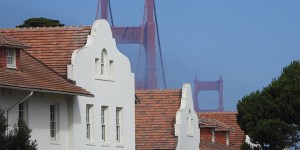Proposal to Develop Fort Winfield Scott is Rejected
Presidio Trust Board decided requirements of moving forward were not met.

San Francisco (June 20, 2019) – The Presidio Trust Board of Directors last night voted to reject a proposal submitted by a consortium of organizations to develop the Presidio’s Fort Winfield Scott (“Fort Scott”) district. A joint proposal submitted by the World Economic Forum, Equity Community Builders, EPIC Institute, the California Clean Energy Fund, OpenAI, The Lela Goren Group, and the We Company, was received on May 24.
Says William Grayson, Chair of the Presidio Trust Board of Directors: “We had a robust, transparent and well-run process to determine whether we could partner with mission-driven organizations to develop Fort Winfield Scott. We greatly appreciate the time and thoughtfulness that the consortium put into this proposal. However, it ultimately didn’t meet enough of the Presidio Trust’s requirements to move forward. We will continue to focus on our many exciting projects, including the new Presidio Theatre, the Tunnel Tops and new development opportunities in the park.”
One of the most magnificent locations in San Francisco, the 30-acre cluster of historic buildings, landscapes, walking trails, and athletic fields sits atop a bluff with sweeping views of the Golden Gate Bridge, San Francisco Bay, and the city skyline. The site features one of the largest groups of historic buildings remaining to be renovated in the Presidio, a national park site at the center of the Golden Gate National Recreation Area in Northern California.
Key Project Objectives outlined in the Request for Proposals were:
- Establish Fort Winfield Scott as a campus for mission-driven organizations focused on addressing the significant environmental and/or social challenges of our time
- Rehabilitate the historic resources – buildings and landscapes
- Be a model of environmental sustainability in design, construction, and operation
- Enhance the public realm
- Enhance the park by supporting the Presidio Trust’s financial sustainability
- Complete the improvements expeditiously
Says Jean Fraser, CEO of the Presidio Trust: “We have been entrusted to care for this public land and to make the right choices for its use and its preservation, with input from the public. At this point, it’s in the best interest of the Presidio to develop the site ourselves.” At the meeting, the board agreed with a staff recommendation published on June 14 that the proposal did not:
- Guarantee that Fort Scott will remain a mission-driven campus for the duration of the lease
- Enhance the park by supporting the Presidio Trust’s financial sustainability
- Include the cost of relocating the US Park Police
- Include a transportation plan that accommodates the proposed density
The Presidio Trust will turn its focus towards developing other sites within the Presidio with the goal of generating revenue in order to develop Fort Scott in a phased approach in the future. This entails rehabilitating the buildings as budget allows, steering the overall campus towards the higher purpose originally envisioned by the first National Park Service Management Plan.
Over the course of the 17-month process, the Trust issued a Request for Concept Proposals, with nine resulting concept proposals received. It issued a Request for Proposals with one joint proposal received, and presented at the April 24 board meeting. Further revisions were submitted on May 14. The public was invited into the process with over 400 people hosted on multiple public tours, and five public board meetings with comments received. The Trust received over 300 public comments throughout the process, and posted all materials on the website Fort Scott.
About the Presidio
The Presidio served as a military installation from its establishment in 1776 as Spain’s northern-most outpost of colonial power in the New World, later passing to Mexico and then the United States. In 1972, Congress created one of the world’s largest national parks in an urban setting – the Golden Gate National Recreation Area – and declared that the Presidio would be part of the GGNRA should the military ever leave. At the end of the Cold War in 1989, Congress decided to close the Presidio. Its 218-year tenure as a military post ended in 1994 when the U.S. Army lowered its flag for the last time and the Presidio became one of the nation’s parks.
Over the past two decades, the Presidio has undergone an exciting “post to park” transformation. The Presidio Trust, the National Park Service, and the non-profit Golden Gate National Parks Conservancy have rehabilitated hundreds of historic buildings as visitor destinations, homes, and workplaces; restored native habitats; built hiking and biking trails; and created destinations and programs to welcome visitors. Learn more at www.presidio.gov.